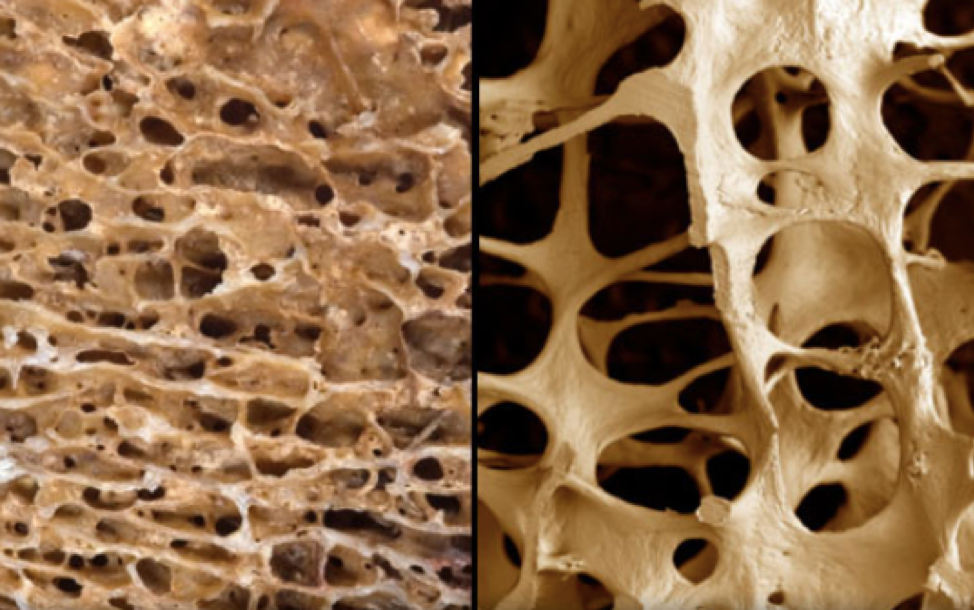
Osteoporosis: What exercise is best?
Exercise is important throughout our lives but as we age it becomes particularly important for our bones. Bones are living tissue, and just like our heart and muscles, our bones need to be exercised to strengthen them and help prevent decline. The two stages of decline in bone health and density are called osteopenia and osteoporosis.

Image by: Scott Camazine/Phototake, Alan Boyde/Visuals Unlimited
What is osteoporosis?
The word ‘osteoporosis’ means ‘bones with holes’. It’s a condition where the bones lose minerals, such as calcium, faster than the body can replace them. This leads to a loss of bone thickness or density and a higher risk of fractures. If you have osteoporosis, even a minor bump or fall could lead to a fracture, possible hospitalisation or joint replacement.
More than one million Australians have osteoporosis. (https://www.osteoporosis.org.au/faq) Most people don’t realise they have it until they have a fracture as there are usually no signs or symptoms. It is more common in adults over 50 and although it affects both men and women, it is more common in women due to skeletal changes during menopause.
Osteopenia is the stage of bone loss just before osteoporosis. If you have osteopenia your bones will continue to weaken unless you stimulate them to re-strengthen and re-model.
Exercise and bone health
As we age, the goals of exercising for bone health change. In childhood and adolescence, the goal is to build maximum bone strength through play and sport activities. In young and mid-adulthood, the aim is to optimise and maintain muscle and bone strength for as long as possible, and in older age, the focus is on reducing bone density loss, improving balance and preventing falls and fractures.
What kind of exercise is best for bones?
It is important to remember that ‘exercise’ is different from ‘physical activity’. When we talk about ‘exercise’ we mean a planned and structured activity completed with the purpose of improving your health – in this case, bone health. Although generally beneficial, physical activities like gardening, going for the occasional walk or doing the household chores are not going to stimulate your body enough to improve your health. So what exercise is best for bones?
Impact loading has been shown to be most effective at improving and maintaining bone mineral density for all ages. Impact loading includes exercises like jumping, skipping, running, stomping and boxing. As long as these exercises are performed in a safe environment where there is no risk of falling, all of these activities are generally safe and recommended even if a person has developed osteoporosis. Impact loading works! When we load our bones through impact exercise, our bones vibrate in a way which causes an influx of cells known as osteoblasts that help to repair and grow new bone. For best results it is recommended that people with osteopenia or osteoporosis combine impact loading with resistance-based exercise.
Resistance-based exercise, that is any exercise completed with the goal of strengthening your muscles (weights machines, body weight exercises like squats, and exercise with resistance bands) is very effective at improving the strength of bones in specific areas. This is because as your muscles contract, they gently pull on the bone and cause an influx of osteoblasts to the area where the muscle attaches to the bone. Resistance based exercise also builds muscle strength, improves balance and mobility, and reduces the risk of falling and experiencing a fracture. For best results, resistance training should be progressive so that it becomes more challenging over time and should be supervised by an exercise physiologist to ensure safety and correct technique.
Non-weight-bearing or low impact activities like yoga, walking, swimming and cycling have several other health benefits, but they do not build bone strength and provide no extra benefit for people with osteoporosis.
Build your bones with a regular exercise routine
To maintain bone health you need to exercise regularly. Remember, ‘exercise’ is different to ‘physical activity’.
To improve bone density exercise should be completed at least three times a week, for 30 to 40 minutes at a time. Aim for a mix of impact-loading exercises, resistance-based exercises and higher intensity aerobic sessions throughout the week. Your exercise should have variety and progress in difficulty over time so that it keeps challenging you. This is best achieved with the guidance and individualised exercise prescription of an exercise physiologist.
If you already have osteoporosis
Research shows that if you already have developed osteoporosis it is unlikely that exercise will dramatically improve your bone density. Rather, impact loading and resistance-based exercise will prevent bone health from getting worse and will slow any further rapid decline in bone density. Unsupervised exercise may not be suitable for people with osteoporosis as the risk of an injury or fracture is high if you complete unsafe exercises. Please consult an exercise physiologist before commencing impact and resistance-based exercise.
Other ways to prevent osteoporosis
As well as impact loading and resistance-based exercise, it is important you eat a healthy, balanced diet that’s rich in calcium and get enough safe sun exposure to ensure you have adequate levels of vitamin D. Both vitamin D and calcium are important for building bone density. For further advise about optimal nutrition for bone density you can arrange to see a Body Smart Health dietitian or talk to your doctor for more information.
To reduce your risk of developing osteopenia or osteoporosis it is recommended that you quit smoking and reduce caffeine and alcohol consumption. All of these modifiable risk factors have been shown to lower bone density.